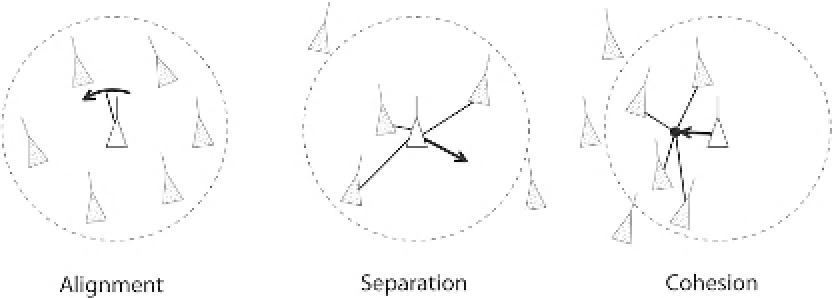Biomedical Engineering Reference
In-Depth Information
region. This gives rise to short-distance repul-
sion between individual birds, which in turns
results in an exclusion zone around each bird.
In one empirical study, the exclusion zone was
found to be 0.38 m in radius and independent
of the flock size
[7]
. The
alignment rule
causes
each bird to fly in the same direction as the
adjacent birds. Finally, the
cohesion rule
steers
the birds on the periphery to position them-
selves so that the flock does not get separated
or broken. The distance and the direction deter-
mine the vicinity of every bird. Flock mates out-
side the local vicinity are ignored. The three
rules are reported to give reasonable and real-
istic simulation results, but more accurate mod-
els also include the avoidance of obstacles
[5]
.
The ability to act in a coordinated fashion and
retain group adherence during predatory events
by a bird of prey is likely to have significant fit-
ness advantages for individual birds as the rap-
tor encounters problems with picking out
individual birds to attack. In general, a collective
response is the hallmark of self-organized dis-
tributive order as opposed to the centralized
order present in hierarchical systems where indi-
viduals follow a leader
[8]
. The ability to act col-
lectively arises from the simple individual
behavioral rules outlined in the previous para-
graph: Each bird typically interacts with up to
seven of its closest neighbors (the interaction dis-
tance). The degree to which non-interacting birds
correlate their behavior depends on how well the
FIGURE 13.1
Murmuration involving large starling
flocks seen on the west coast of Denmark. Photograph repro-
duced with kind permission from
www.sortsafari.dk
.
Researchers in the computer science commu-
nity have long been interested in simulating this
flock behavior. One application area is realistic
animations of animal flocks on film; feasible
explanations of the animal behavior can there-
fore be found in the computer-science literature
[5, 6]
. Reynolds describes one explanation of the
mechanism behind the starlings' agile naviga-
tion in terms of three simple rules that each bird
obeys: the separation rule, the alignment rule,
and the cohesion rule, as shown in
Figure 13.2
[5, 6]
. The
separation rule
makes sure that the
birds avoid crowding within the flock. If the
number of birds within a local region becomes
too big, the outsiders avoid getting into this
FIGURE 13.2
Three local rules birds use to navigate within a flock: the alignment rule (left), the separation rule (middle),
and the cohesion rule (right). Drawing based on description in Ref.
5
.


